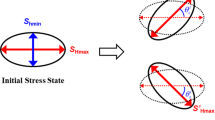In recent years, the commercially developed tight conglomerate reservoirs have been benefiting from the continuous progress of fracturing technology. The overall development trend of fracturing is focused on providing small well spacing, large-scale cutting, and cross-well fracturing. The productive construction of new wells is restricted by fracture interference. In this paper, to improve the accuracy of the fracturing design and the final recoverable reserves (EUR) of the well groups, the authors have put forward a new fracturing optimization method. Based on a discrete fracture model and the dynamic in-situ stress field data, they have established a refined three-dimensional in-situ stress model. The model is solved by the coupling analysis of finite element geomechanics and seepage mechanics, combined with the production data. The model is applied to simulate the evolution of the reservoir in-situ stress field under the condition of the formation energy deficit. Then, the fracture distribution of the new wells in the new dynamic in-situ stress field is simulated, and the fracturing parameters are optimized according to the comparison of the predicted productivity data for different schemes. Taking the well group H1 in the Jin 202 demonstration area as an example, the method has been applied to analyze the factors determining lower productivity after the new wells are put into production. Based on subsection clustering and pump-injection design, the authors have put forward the principles of design optimization of the new wells. As shown by the analysis results, the dynamic in-situ stress model incorporating the influence caused by the production of the old wells is applicable for the evaluation and interactive characterization of fractured layers of the new wells. When the new wells are characterized by significant cross-well interference of fractures, the new model provides an important basis for predicting productivity and optimizing fracturing parameters. When the target horizontal well group is fractured with a cluster spacing of 20 m and a preflush ratio of 55%, the maximum productivity is obtained and the development effect is the best.







Similar content being viewed by others
References
X. Ma, “Extreme utilization” development theory of unconventional natural gas,” Pet. Explor. Dev., 48(2), 326-336 (2021).
J. Deng, X. Guo, Y. Sun, B. Qi, and W. Lei, “Directional perforation optimization technology for fractured wells in tight gas reservoirs,” Pet. Drill. Prod. Technol., 30(6), 93-96 (2008).
F. Du, J. Li, Y. Qi, H. Lu, C. Wang, and G. Yin, “Multi-stage fracturing technology for deviated wells in dense and thick oil reservoirs,” Pet. Drill. Prod. Technol., 34(4), 61-63 (2012).
Q. Zeng and J. Yao, “Numerical simulation of shale hydraulic fracturing based on extended finite element method,” App. Math. Mech., 35(11), 1239-1248 (2014).
Y. Li, C. Ai, B. Zhang, Y. Luan, L. Dan, and H. Wang, “Influence of synchronous fracturing on cross-well fracture characteristics,” Fault Block Oil Gas Field, 20(06), 779-782 (2013).
J. Gupta, M. Zielonka, R. A. Albert, et al., “Integrated methodology for optimizing development of unconventional gas resources,” SPE Hydraulic Fracturing Technology Conference, The Woodlands, Texas, USA (2012).
X. Guo, K. Wu, J. Killough, et al., “Understanding the mechanism of interwell fracturing interference with reservoir/geomechanics/fracturing modeling in Eagle Ford shale,” SPE Reserv. Eval. Eng., 22(3), 842-860 (2019).
X. Zhao, H. Guo, Z. Li, and Y. Niu, “In-situ stress field and rock mechanics parameter modeling based on logging shear wave prediction,” Fault Block Oil Gas Field, 02, 235-240 (2021).
B. Lin, C. Shi, L. Zhuang, H. You, and Y. Huang, “Study on fracture propagation law of super heavy oil reservoir based on true triaxial test,” Pet. Explor. Dev., 47(3), 608-616 (2020).
F. Yao, C. Mian, X. Wu, and G. Zhang, “Physical simulation of hydraulic fracture extension in natural fractured formations,” Pet. Explor. Dev., 30(3), 83-86 (2008).
Z. Wang and J. Hu, “Study on fracture morphology formed by hydraulic fracturing,” Pet. Explor. Dev., 06, 66-69 (1994).
Author information
Authors and Affiliations
Corresponding author
Additional information
Translated from Khimiya i Tekhnologiya Topliv i Masel, No. 6, pp. 81–87, September-October, 2021.
Rights and permissions
About this article
Cite this article
Cheng, F., Li, Y., Wang, M. et al. Fracturing Optimization of New Wells Considering Cross-Well Interference in the Mahu Conglomerate Reservoir. Chem Technol Fuels Oils 57, 1022–1029 (2022). https://doi.org/10.1007/s10553-022-01339-x
Published:
Issue Date:
DOI: https://doi.org/10.1007/s10553-022-01339-x



